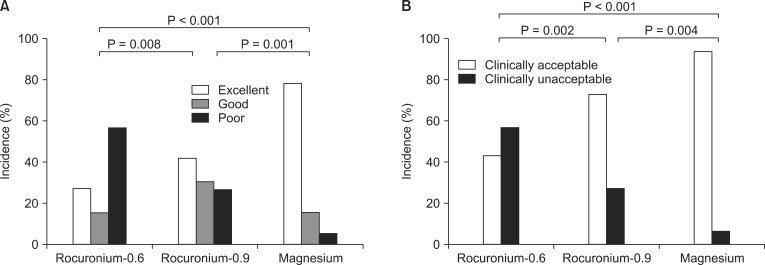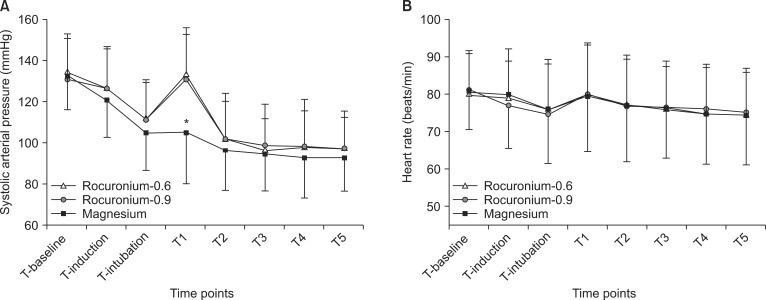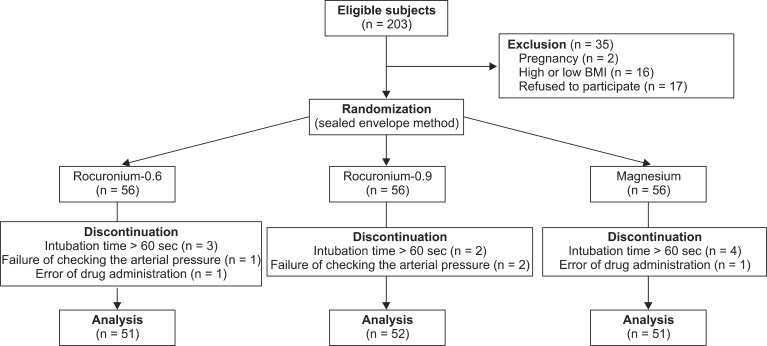1. Neelakanta G, Chikyarappa A. A review of patients with pulmonary aspiration of gastric contents during anesthesia reported to the Departmental Quality Assurance Committee. J Clin Anesth. 2006; 18:102–107. PMID:
16563326.

2. Sluga M, Ummenhofer W, Studer W, Siegemund M, Marsch SC. Rocuronium versus succinylcholine for rapid sequence induction of anesthesia and endotracheal intubation: a prospective, randomized trial in emergent cases. Anesth Analg. 2005; 101:1356–1361. PMID:
16243994.

3. Magorian T, Flannery KB, Miller RD. Comparison of rocuronium, succinylcholine, and vecuronium for rapid-sequence induction of anesthesia in adult patients. Anesthesiology. 1993; 79:913–918. PMID:
7902034.

4. Weiss JH, Gratz I, Goldberg ME, Afshar M, Insinga F, Larijani G. Double-blind comparison of two doses of rocuronium and succinylcholine for rapid-sequence intubation. J Clin Anesth. 1997; 9:379–382. PMID:
9257203.

5. Pinard AM, Donati F, Martineau R, Denault AY, Taillefer J, Carrier M. Magnesium potentiates neuromuscular blockade with cisatracurium during cardiac surgery. Can J Anaesth. 2003; 50:172–178. PMID:
12560310.

6. Ahn EK, Bai SJ, Cho BJ, Shin YS. The infusion rate of mivacurium and its spontaneous neuromuscular recovery in magnesium-treated parturients. Anesth Analg. 1998; 86:523–526. PMID:
9495406.

7. Fuchs-Buder T, Wilder-Smith OH, Borgeat A, Tassonyi E. Interaction of magnesium sulphate with vecuronium-induced neuromuscular block. Br J Anaesth. 1995; 74:405–409. PMID:
7734259.
8. Czarnetzki C, Lysakowski C, Elia N, Tramer MR. Time course of rocuronium-induced neuromuscular block after pre-treatment with magnesium sulphate: a randomised study. Acta Anaesthesiol Scand. 2010; 54:299–306. PMID:
19919585.

9. Lee C. Goodbye suxamethonium! Anaesthesia. 2009; 64(Suppl 1):73–81. PMID:
19222434.

10. Perry JJ, Lee JS, Sillberg VA, Wells GA. Rocuronium versus succinylcholine for rapid sequence induction intubation. Cochrane Database Syst Rev. 2008; (2):CD002788. PMID:
18425883.

11. Fuchs-Buder T, Claudius C, Skovgaard LT, Eriksson LI, Mirakhur RK, Viby-Mogensen J. Good clinical research practice in pharmacodynamic studies of neuromuscular blocking agents II: the Stockholm revision. Acta Anaesthesiol Scand. 2007; 51:789–808. PMID:
17635389.

12. Fawcett WJ, Haxby EJ, Male DA. Magnesium: physiology and pharmacology. Br J Anaesth. 1999; 83:302–320. PMID:
10618948.

13. Dube L, Granry JC. The therapeutic use of magnesium in anesthesiology, intensive care and emergency medicine: a review. Can J Anaesth. 2003; 50:732–746. PMID:
12944451.
14. James MF, Beer RE, Esser JD. Intravenous magnesium sulfate inhibits catecholamine release associated with tracheal intubation. Anesth Analg. 1989; 68:772–776. PMID:
2735543.

15. Lysakowski C, Suppan L, Czarnetzki C, Tassonyi E, Tramer MR. Impact of the intubation model on the efficacy of rocuronium during rapid sequence intubation: systematic review of randomized trials. Acta Anaesthesiol Scand. 2007; 51:848–857. PMID:
17635392.

16. Larsen PB, Hansen EG, Jacobsen LS, Wiis J, Holst P, Rottensten H, et al. Intubation conditions after rocuronium or succinylcholine for rapid sequence induction with alfentanil and propofol in the emergency patient. Eur J Anaesthesiol. 2005; 22:748–753. PMID:
16211732.

17. Hubbard JI, Jones SF, Landau EM. On the mechanism by which calcium and magnesium affect the spontaneous release of transmitter from mammalian motor nerve terminals. J Physiol. 1968; 194:355–380. PMID:
4295698.

18. O'Hare R, McAtamney D, Mirakhur RK, Hughes D, Carabine U. Bolus dose remifentanil for control of haemodynamic response to tracheal intubation during rapid sequence induction of anaesthesia. Br J Anaesth. 1999; 82:283–285. PMID:
10365011.
19. Miller DR, Martineau RJ, O'Brien H, Hull KA, Oliveras L, Hindmarsh T, et al. Effects of alfentanil on the hemodynamic and catecholamine response to tracheal intubation. Anesth Analg. 1993; 76:1040–1046. PMID:
8484505.

20. Sparr HJ, Giesinger S, Ulmer H, Hollenstein-Zacke M, Luger TJ. Influence of induction technique on intubating conditions after rocuronium in adults: comparison with rapid-sequence induction using thiopentone and suxamethonium. Br J Anaesth. 1996; 77:339–342. PMID:
8949806.

21. Servin FS, Billard V. Remifentanil and other opioids. Handb Exp Pharmacol. 2008; (182):283–311. PMID:
18175097.

22. Geisler FE, de Lange S, Royston D, Demeyere R, Duthie DJ, Lehot JJ, et al. Efficacy and safety of remifentanil in coronary artery bypass graft surgery: a randomized, double-blind dose comparison study. J Cardiothorac Vasc Anesth. 2003; 17:60–68. PMID:
12635062.

23. Bennett JA, Abrams JT, Van Riper DF, Horrow JC. Difficult or impossible ventilation after sufentanil-induced anesthesia is caused primarily by vocal cord closure. Anesthesiology. 1997; 87:1070–1074. PMID:
9366458.

24. Kohno T, Ikoma M. Sudden vocal cord closure during general anesthesia using remifentanil. Masui. 2008; 57:1213–1217. PMID:
18975534.
25. Sakuraba S, Serita R, Kosugi S, Eriksson LI, Lindahl SG, Takeda J. Pretreatment with magnesium sulphate is associated with less succinylcholine-induced fasciculation and subsequent tracheal intubation-induced hemodynamic changes than precurarization with vecuronium during rapid sequence induction. Acta Anaesthesiol Belg. 2006; 57:253–257. PMID:
17067136.
26. Puri GD, Marudhachalam KS, Chari P, Suri RK. The effect of magnesium sulphate on hemodynamics and its efficacy in attenuating the response to endotracheal intubation in patients with coronary artery disease. Anesth Analg. 1998; 87:808–811. PMID:
9768774.

27. Lysakowski C, Dumont L, Czarnetzki C, Tramer MR. Magnesium as an adjuvant to postoperative analgesia: a systematic review of randomized trials. Anesth Analg. 2007; 104:1532–1539. PMID:
17513654.

28. Fuchs-Buder T, Tassonyi E. Magnesium sulphate enhances residual neuromuscular block induced by vecuronium. Br J Anaesth. 1996; 76:565–566. PMID:
8652332.

29. Ryu JH, Kang MH, Park KS, Do SH. Effects of magnesium sulphate on intraoperative anaesthetic requirements and postoperative analgesia in gynaecology patients receiving total intravenous anaesthesia. Br J Anaesth. 2008; 100:397–403. PMID:
18276652.

30. Seyhan TO, Tugrul M, Sungur MO, Kayacan S, Telci L, Pembeci K, et al. Effects of three different dose regimens of magnesium on propofol requirements, haemodynamic variables and postoperative pain relief in gynaecological surgery. Br J Anaesth. 2006; 96:247–252. PMID:
16311277.









 PDF
PDF Citation
Citation Print
Print



 XML Download
XML Download